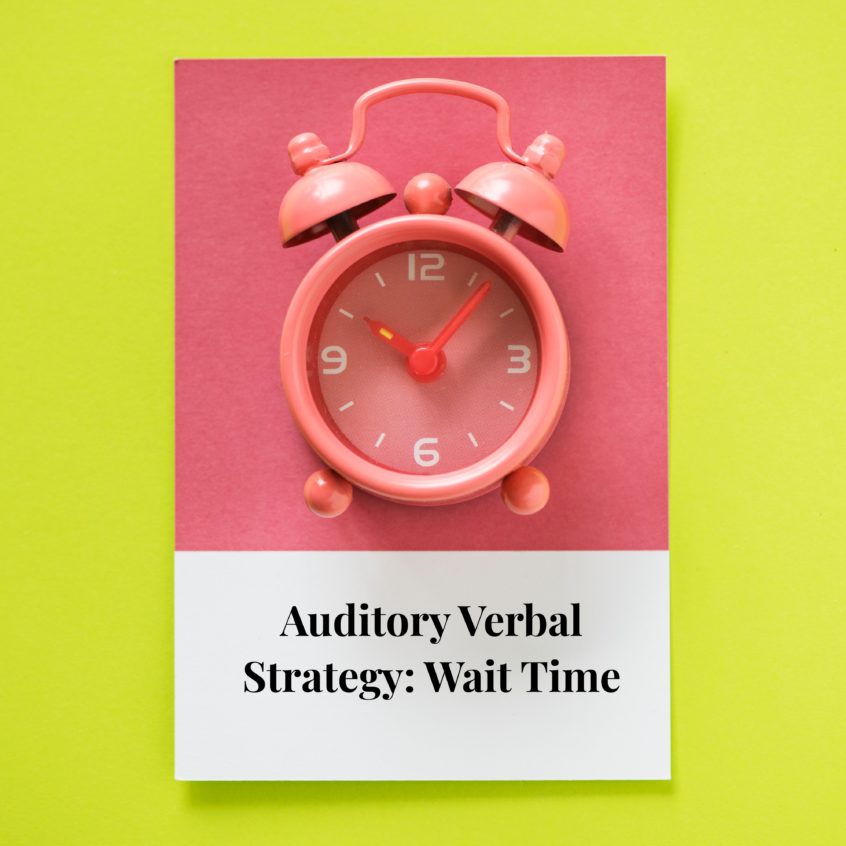Think about the last time you sat in a class or a meeting at work, and the speaker asked “Are there any questions?” How many times have you had a question just formulated, or on the tip of your tongue, and then the speaker moved on to the next topic? This is an example of not enough wait time.
What is Wait Time?
Wait time is simply the amount of time you give your child to answer after you ask a question. You ask them a question like “What color bowl do you want?” and then wait…and it feels like you’re waiting forever…and then, as parents, we want to rescue our children, so we either ask again “Which bowl do you want?” or we answer for them “Let’s do the red bowl today.”
We need to stop. And wait. Even when it’s awkward.

Why Should We Increase Our Wait Time?
Research has shown that increased wait time benefits all students. This study with children with multiple disabilities, found that when wait time increased, the participants were twice as likely to respond.
Even kids with typical hearing benefit from wait time beyond 3 seconds–when given longer wait time, typically hearing students respond more often, with longer answers, remember more things, and the list goes on.
Wait time is really thinking time…it’s time to process what you heard, understand it, and formulate a response. Think back to the last time you were ready to talk but the speaker moved on…you may have been thinking about your grocery list, but you also may have been thinking about the question asked, thinking of your answer, and thinking about the best way to present it.
Wait Time for Kids with Hearing Loss
So, now think about your child with hearing loss who is in speech therapy or auditory verbal therapy. If you are working on listening and spoken language outcomes, you’re working on listening skills. One of those listening skills is comprehension…understanding what was said. Your child is learning that skill, and working on it, so it’s only logical that he or she may need more time to process and understand what was said.
That’s the input (receptive language) part–giving them time to understand what was said. Then, there’s the output (expressive language) part. Many children who are working on listening are also working on talking…so not only are they needing time to process and understand what you said, but they also need time to think about what they want to say, how they should say it, what words to use, what order the words go in, etc.
It’s a lot, right?

Giving Your Child More Wait Time
When things are hard for our kids, we tend to want to save them. At least I do. You want to jump in, do it for them, keep them from the hard things. But that isn’t really helping them in the long run. Instead, we need to equip our kids, prepare them for the road ahead, instead of preparing the road ahead for them.
Wait time is one of those ways. Here are some strategies to be more conscious of our own wait time and increasing it for our kids’ benefit:
- Actually count in your head after you ask your child a question. We often think we’re giving far more wait time than we really are. Start by counting up to 10 before asking again or jumping in.
- Get comfortable with silence. It may feel awkward at first, but eventually it will feel normal. If your child is older and you’re working on this, go ahead and explain to them that you want to give them enough time to think, and tell them it may feel weird at first, but you’ll both get used to it.
- Use a timer if you need to. If you find yourself really struggling to give enough wait time, set the timer on your phone or watch, and let it help you find that long enough wait time for you and your child.
- Make yourself a visual reminder. It could be a stop sign you print out, or a sign on your refrigerator that says “Stop and wait!” Do whatever will help you remember to stop and wait.
Regardless of how you do it, work on increasing your wait time, and see what your child does. Sometimes we’re surprised when we step back and both expect more of our children, and allow them the space and time to surprise us.

